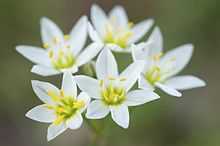Nothoscordum bivalve
| crowpoison or false garlic | |
|---|---|
 | |
| Conservation status | |
| Scientific classification | |
| Kingdom: | Plantae |
| Clade: | Angiosperms |
| Clade: | Monocots |
| Order: | Asparagales |
| Family: | Amaryllidaceae |
| Subfamily: | Allioideae |
| Genus: | Nothoscordum |
| Species: | N. bivalve |
| Binomial name | |
| Nothoscordum bivalve (L.) Britton | |
| Synonyms[1] | |
|
Species synonymy
| |
Nothoscordum bivalve is a species of flowering plant in the Amaryllidaceae known by the common names crowpoison and false garlic. It is native to the southern United States from Arizona to Virginia, as well as Mexico, Peru, Uruguay, northeastern Argentina and central Chile.[2][3]
Nothoscordum bivalve is a perennial herb growing from a bulb about a centimeter wide. It produces one erect stem, or occasionally two. They grow up to 40 centimeters tall. There are one to four narrow leaves up to 30 centimeters long. The inflorescence is an umbel of 3 to 6 flowers, or sometimes up to 10. There are two bracts at the base of the umbel. The flower has six whitish tepals, each of which usually has a dark reddish midvein.[2] The flower has no scent.[4] The fruit is a capsule.[2]
This is a common plant which grows in parks and on roadsides, and soils which are not too dry or too wet.[4]
References
- ↑ The Plant List
- ↑ 2.0 2.1 2.2 Nothoscordum bivalve. Flora of North America.
- ↑ Kew World Checklist of Selected Plant Families
- ↑ 4.0 4.1 Nothoscordum bivalve. USDA NRCS Plant Fact Sheet.
